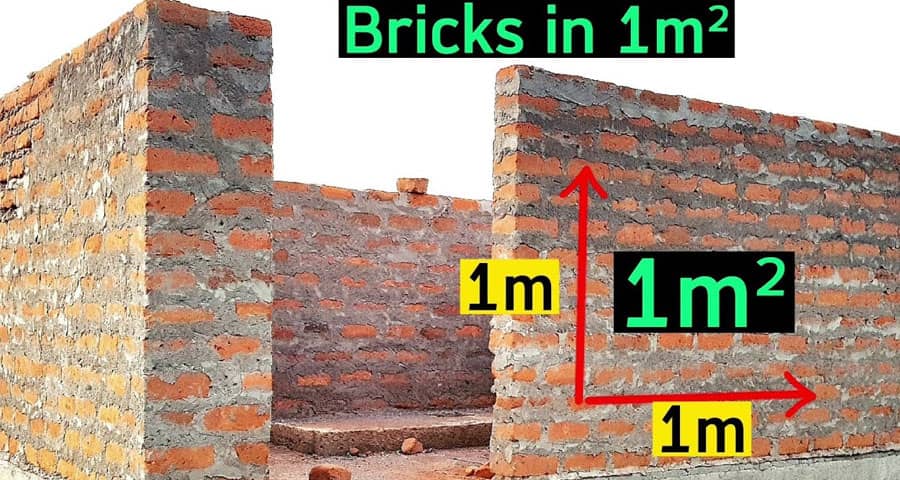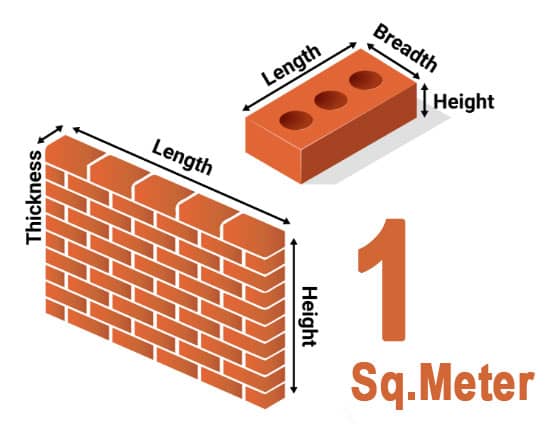How Many Bricks Are Needed for 1 Sq. Meter?

When planning a construction project, accurate material estimation is essential to avoid wastage and ensure cost-efficiency. One of the most commonly used materials in masonry construction is brick, and a fundamental question that arises is: how many bricks are needed for 1 square meter?
Standard Brick Dimensions: A Key Factor
The size of the brick is the most critical factor in determining how many bricks are needed per square meter. In most countries, especially in India, the UK, and many Commonwealth nations, the standard brick size is:
- Length: 190 mm
- Width: 90 mm
- Height: 90 mm
However, with mortar (usually 10 mm thick), the modular size becomes:
- Length: 200 mm
- Height: 100 mm
Using the modular size, we can calculate the number of bricks needed per square meter.
How to Calculate Number of Bricks per Square Meter
To compute the number of bricks required, we use the following formula:
Number of Bricks = 1 / (Brick Length x Brick Height)
Let's plug in the standard modular size:
Number of Bricks = 1 / (0.2 x 0.1) = 1 / 0.02 = 50 bricks
Thus, 50 bricks are required for 1 square meter of single-layer brickwork, when using standard modular bricks with mortar.
Brick Requirement Based on Brick Type
Different brick sizes exist based on country and usage. Here's a comparison:
| Brick Type | Size with Mortar (mm) | Bricks per Sq. Meter |
|---|---|---|
| Standard Modular Brick | 200 x 100 | 50 |
| Traditional UK Brick | 225 x 75 | 60 |
| U.S. Standard Modular Brick | 203 x 67 | ~70 |
| Roman Brick | 305 x 50 | ~65 |
| Norman Brick | 290 x 90 | ~38 |

Always adjust the calculation based on the actual size of the brick used, including the mortar joint.
Brickwork Thickness: One Brick vs. Half Brick Wall
The number of bricks required also depends on the type of wall construction:
Half Brick Wall (Single Layer)
- Thickness: ~100 mm
- Used for: Partition walls, non-load bearing structures
- Bricks per m2: 50 (standard modular size)
One Brick Wall (Double Layer)
- Thickness: ~200 mm
- Used for: Load-bearing external walls
- Bricks per m2: 100 (two layers, back-to-back)
Hence, for a one-brick-thick wall, double the number of bricks per square meter.
Mortar Considerations
Mortar thickness typically ranges from 10 to 12 mm. While it doesn't drastically change the number of bricks, it affects the joint spacing and can cause slight variations. For more precise calculations in large-scale construction, mortar consumption must also be estimated:
- For 1 m2 of half brick wall, mortar required is approximately 0.02 m3
- For 1 m2 of one brick wall, it goes up to 0.04 m3
Accurate volume calculations ensure enough mortar is mixed, avoiding mid-project shortages.
Allowance for Breakage and Wastage
It is essential to add a contingency for breakage, cutting, and wastage. Generally, we suggest the following margins:
- 5% extra for small residential projects
- 7 - 10% extra for commercial or large-scale jobs
So, for a 1 m2 area requiring 50 bricks:
- Add 5%: 50 + (50 x 0.05) = 52.5 ≈ 53 bricks
Always round up the final quantity.
Real-Life Examples: How Many Bricks Needed Per Square Meter in Different Scenarios
Residential Partition Wall (Half Brick)
- Area: 10 m2
- Bricks Needed: 10 x 50 = 500
- Wastage (5%): 25
- Total: 525 bricks
Boundary Wall (One Brick Thickness)
- Area: 20 m2
- Bricks Needed: 20 x 100 = 2000
- Wastage (7%): 140
- Total: 2140 bricks
How to Reduce Brick Requirement Without Compromising Quality
Here are a few efficient construction techniques to reduce material usage:
- Use of fly ash bricks or AAC blocks (larger in size)
- Optimizing wall thickness where feasible
- Avoiding unnecessary partitions
- Precise cutting and alignment to reduce wastage
Such practices also improve sustainability and lower overall construction costs.
Quick Reference Table: Bricks per Square Meter
| Wall Type | Brick Size (mm) | Bricks per m2 | With 5% Wastage |
|---|---|---|---|
| Half Brick Wall | 200 x 100 | 50 | 53 |
| One Brick Wall | 200 x 100 | 100 | 105 |
| UK Standard Brick | 225 x 75 | 60 | 63 |
| U.S. Modular Brick | 203 x 67 | 70 | 74 |
Conclusion
In conclusion, the number of bricks required per square meter depends on brick size, wall thickness, and mortar joints. For standard modular bricks with a 10 mm mortar joint in a half brick wall, 50 bricks per square meter is the rule of thumb. However, every construction project is unique, and precise estimation is key to cost-effective and efficient building. Incorporate allowance for wastage, and consider the wall type to arrive at accurate material quantities.
Please view the following short video for the Bricks Are Needed for 1 Sq. Meter
